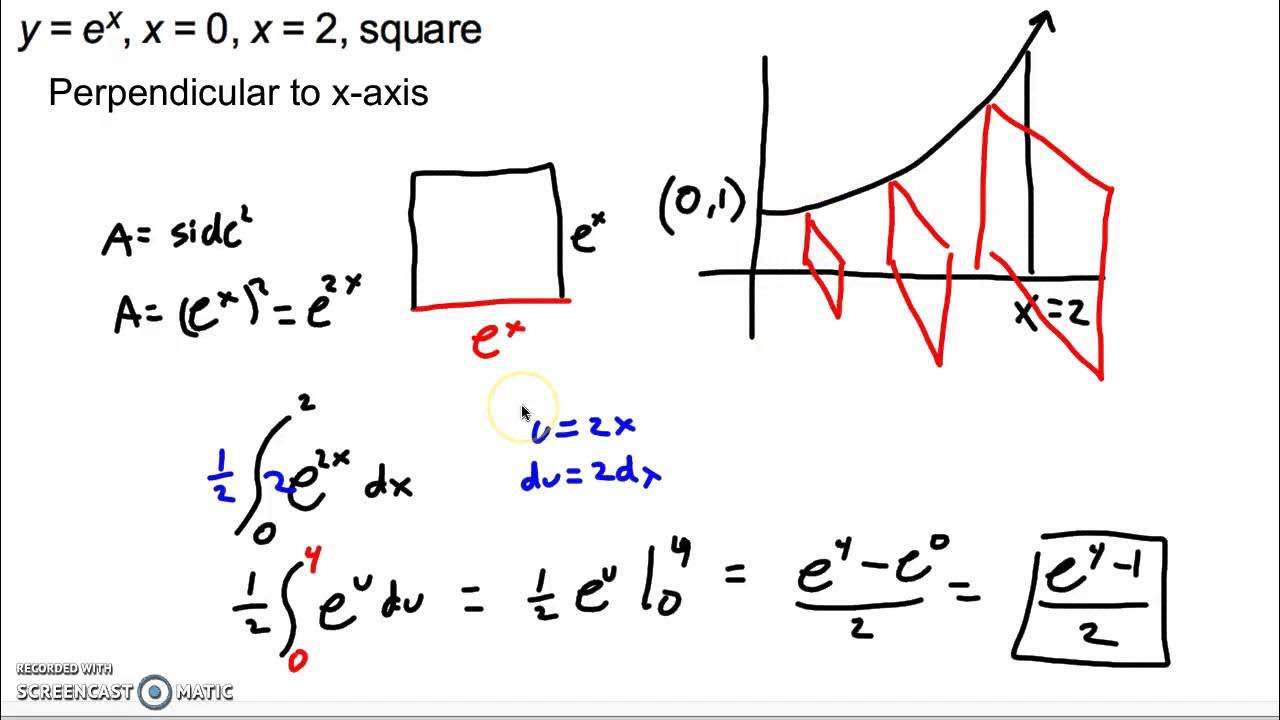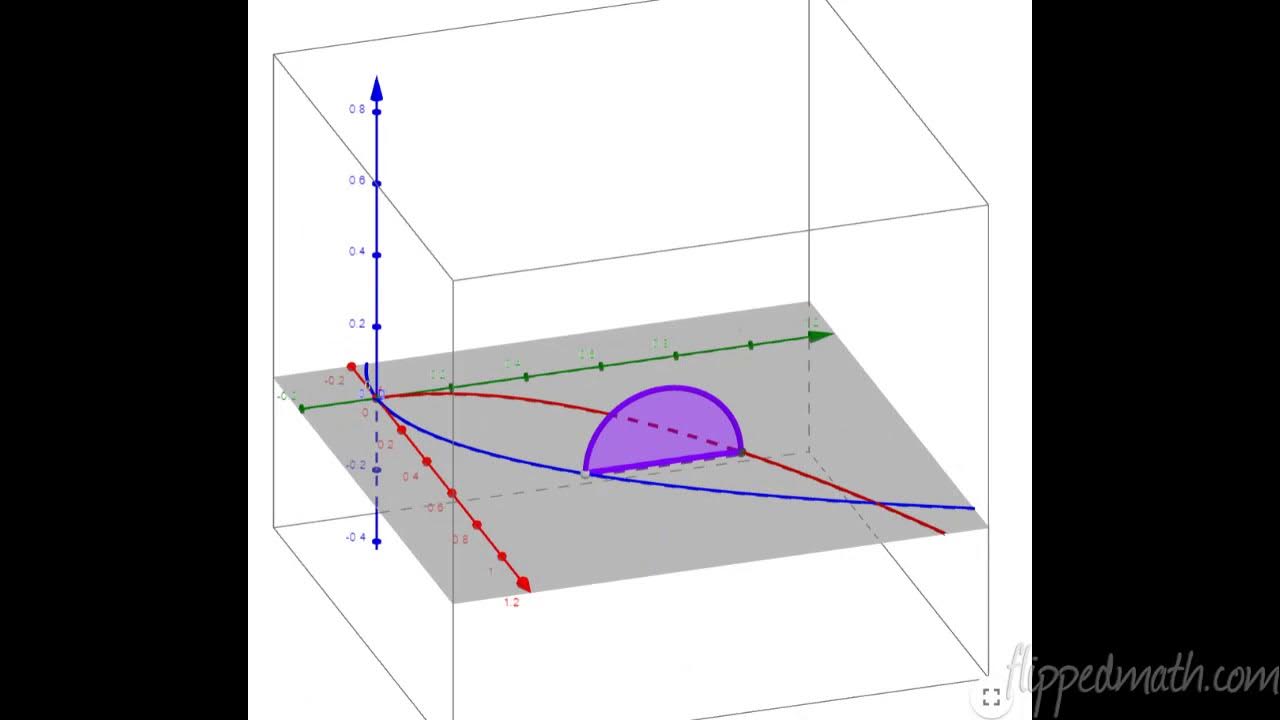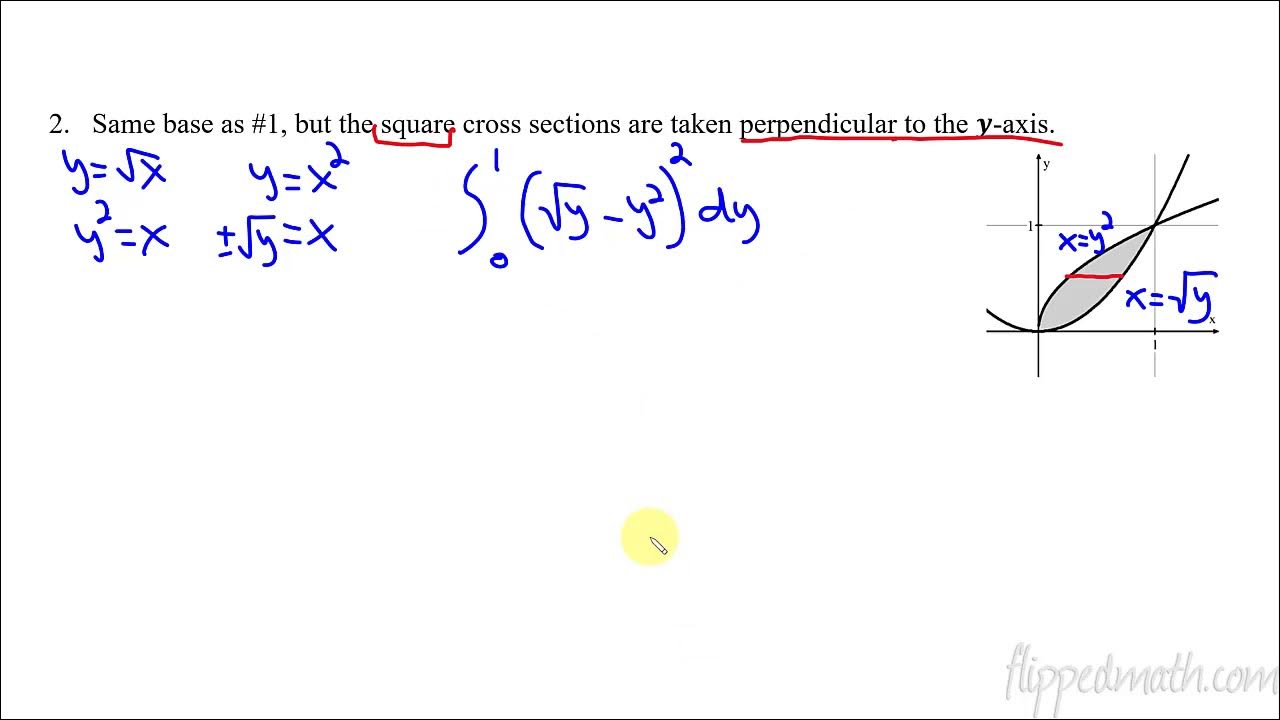Topic 43-Volumes of Solids with Known Cross Sections
TLDRThe video script is a comprehensive calculus lecture focusing on the calculation of volumes of solids with known cross-sections. The instructor begins by explaining the concept of cross-sections in 3D objects and how they appear when an object is sliced vertically or horizontally. Using the example of a pyramid, the lecture demonstrates how to visualize and calculate the volume of a solid when cross-sections are perpendicular to the x-axis. The process involves integrating the area of the base, represented by the difference between two functions, over the interval defined by the object's boundaries. The lecture covers various geometric shapes, including squares, rectangles, semicircles, quarter circles, isosceles triangles, and equilateral triangles, emphasizing the importance of knowing their area formulas. Practical examples are provided, such as calculating the volume of a pyramid with square cross-sections and a solid with semicircle cross-sections. The instructor also mentions that understanding this topic is crucial for preparing for the second-semester final project, which involves creating 3D models with different cross-section shapes. The lecture concludes with a teaser for the next class, where more examples will be explored visually.
Takeaways
- 📐 **Cross-Sections in 3D Objects**: A cross-section is a 2D shape obtained by slicing a 3D object either vertically or horizontally.
- 📈 **Solids on Coordinate Graphs**: When a solid is sliced perpendicular to the x-axis, the cross-sections are squares, which can be visualized on a coordinate graph.
- 🧱 **Volume Calculation**: The volume of a solid with known cross-sections is found by multiplying the area of the base by the height (change in x or y, depending on the orientation of the cross-section).
- 👀 **Bird's-Eye View**: To find the area of the base for volume calculation, a bird's-eye view (top-down perspective) is useful, which resembles finding the area between two curves.
- 📐 **Integration for Volume**: The volume is calculated by integrating the area of the cross-section from one boundary to another (from x=a to x=b or y=c to y=d).
- 🔢 **Area Formulas**: Knowledge of area formulas for squares, rectangles, semicircles, quarter circles, isosceles triangles, and equilateral triangles is required, as these are not provided on the AP test.
- 🏗️ **Example: Pyramid Volume**: The volume of a pyramid with square cross-sections is calculated by integrating the square of the difference between the top and bottom functions over the given interval.
- 🛕 **Example: Solid with Semicircle Cross-Sections**: For a solid with semicircle cross-sections, the volume is found by integrating the area of a semicircle (π * (radius squared) / 2) between the boundaries defined by the curves.
- 📉 **Determining Top and Bottom Functions**: To calculate the area of a cross-section, it is crucial to identify which function represents the top and which represents the bottom.
- 📚 **Geometry Knowledge**: Geometry class knowledge is essential for understanding and applying the formulas for the areas of different shapes.
- 🎓 **AP Test Preparation**: The concepts covered in this topic are beneficial for preparing for the second-semester final project in calculus, which may involve creating 3D models with specific cross-sections.
Q & A
What is a cross-section in the context of 3D objects?
-A cross-section is a 2D representation obtained by slicing a 3D object either vertically or horizontally.
How does the orientation of slicing affect the shape of the cross-section?
-The orientation of slicing determines the shape of the cross-section; for instance, slicing a pyramid vertically results in equilateral triangles, while slicing it horizontally results in squares.
What is the process of turning a pyramid onto its side and cutting it perpendicular to the x-axis?
-This process involves visualizing the pyramid on its side and then conceptually cutting it into infinite slices perpendicular to the x-axis to create cross-sections.
What is the formula for calculating the volume of a solid with known cross-sections?
-The volume of a solid with known cross-sections is calculated by integrating the area of the cross-section times the change in x (dx) from x=a to x=b, where a and b are the limits of the solid.
What is the bird's-eye view used for in the context of calculating volume?
-The bird's-eye view provides a 2D perspective of the cross-section, which helps in determining the area of the base, necessary for calculating the volume of the solid.
What are some of the common 2D geometric shapes and their area formulas that are needed to calculate the volume of a solid?
-Some common shapes and their area formulas include squares (side^2), rectangles (length * width), semicircles (PI * R^2 / 2), quarter circles (PI * R^2 / 4), isosceles triangles (base^2 / 2), and equilateral triangles (sqrt(3) * base^2 / 4).
How do you find the volume of a pyramid with square cross-sections?
-To find the volume of a pyramid with square cross-sections, you integrate the side length squared (from the top curve minus the bottom curve) with respect to x over the interval defined by the base limits.
What is the volume of a pyramid with a base bounded by y = 1/2x - 1, y = -1/2x + 1, x = 0, and x = 2?
-The volume of the pyramid is 8/3 cubic units, calculated by integrating the square of the difference between the top and bottom curves over the interval from x=0 to x=2.
How do you determine the radius of a semicircle cross-section for a solid bounded by two curves?
-The radius of a semicircle cross-section is half the diameter, which is the difference between the top curve and the bottom curve at a given x-value.
What is the area formula used for a semicircle cross-section in the calculation of volume?
-The area formula for a semicircle is PI * R^2 / 2, where R is the radius of the semicircle.
What are some examples of solids with known cross-sections that were mentioned in the script?
-Examples include Mr. Peanut made with semicircle cross sections perpendicular to the y-axis, a shark's tail or fin made with equilateral triangle cross sections perpendicular to the x-axis, and a bird made with semicircle cross sections perpendicular to the x-axis.
Outlines
📚 Understanding Cross-Sections and Calculating Volumes
This paragraph introduces the concept of cross-sections in 3D objects and how they can be visualized on a coordinate graph. The video explains the process of slicing a pyramid both vertically and horizontally to obtain 2D cross-sections, which are equilateral triangles and squares respectively. It then demonstrates how to calculate the volume of a single cross-section by considering it as a thin rectangular prism or square. The area of the base is determined using a bird's-eye view, which resembles finding the area between two curves. The volume of the solid is found by integrating the area of the cross-section times the change in X (DX) from a to B, where a and B are the limits of the solid along the x-axis.
📐 Area Formulas and Volume Calculation Examples
The second paragraph delves into the area formulas for various geometric shapes, including squares, rectangles, semicircles, quarter circles, isosceles triangles, and equilateral triangles. These formulas are essential for calculating the volume of solids with known cross-sections. An example problem is presented where the base of a solid is bounded by certain functions, and the volume is to be found assuming each cross-section is a square perpendicular to the x-axis. The process involves integrating the squared difference between the top and bottom functions over the given interval. Another example is given involving semicircle cross-sections, where the radius is determined by the difference between the top and bottom functions, and the volume is calculated by integrating the area of the semicircle over the interval from -2 to 2.
🎨 Visualizing Solids with Known Cross-Sections
The final paragraph discusses the application of the previously explained concepts to create 3D models of various shapes, such as Mr. Peanut made with semicircle cross sections, a shark's tail or fin made with equilateral triangles, and a bird also made with semicircle cross sections. These examples serve to illustrate the practical use of the volume calculation methods for different cross-section shapes. The instructor also mentions that the topic will be helpful for preparing for a second-semester final project, which is an actual modeling task. The video concludes with an invitation to the next class and well wishes for the night.
Mindmap
Keywords
💡Cross-sections
💡Volume
💡Integration
💡Solids with known cross-sections
💡Area of the base
💡Bird's-eye view
💡Geometric shapes
💡Change in X (dx)
💡Perpendicular to the x-axis
💡Linear functions
💡AP test
Highlights
Introduction to the concept of cross-sections in 3D objects and their importance in calculating volumes.
Demonstration of slicing a pyramid both vertically and horizontally to obtain different 2D cross-sections.
Visualization of the pyramid on a coordinate graph, showing how to create cross-sections perpendicular to the x-axis.
Explanation of the volume calculation for a single cross-section as the area of the base times the height.
Use of the bird's-eye view to find the area between two curves, which is crucial for determining the base area.
Presentation of the mathematical model for calculating the volume of a solid with known cross-sections.
Differentiation between calculating volumes when cross-sections are perpendicular to the x-axis and y-axis.
List of area formulas for common 2D shapes that are essential for volume calculations.
Application of the area formulas in an example problem involving a pyramid with square cross-sections.
Integration of the area of the cross-section to find the volume of the pyramid.
Guidance on solving a problem with a solid bounded by graphs, involving semicircle cross-sections.
Method for finding the diameter and radius of a semicircle to calculate the volume of the solid.
Integration of the area of a semicircle from given limits to find the volume of the solid.
Discussion on how the topic relates to preparing for the second-semester final project.
Showcase of past projects, including Mr. Peanut made with semicircle cross sections and other geometric solids.
Emphasis on the importance of understanding geometry for success in calculus and AP tests.
Encouragement for students to practice the topic on their own before the next class.
Closing remarks, looking forward to the next class and wishing students a good night.
Transcripts
Browse More Related Video

Volume Using Known Cross Sections (Slicing) | Calculus 2 Lesson 5 - JK Math

Calculating volume by known cross sections

Calculus AB/BC – 8.8 Volumes with Cross Sections: Triangles and Semicircles

Calculus Integrals for Volumes with Known Cross Sections

Calculus AB/BC – 8.7 Volumes with Cross Sections: Squares and Rectangles

Volumes with Known Cross Sections with Calculus, pg 2
5.0 / 5 (0 votes)
Thanks for rating: